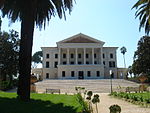Villa Lituania
Foreign relations of ItalyLithuania–Soviet Union relationsVillas in Rome
Villa Lituania is a villa in Rome, Italy, at Via Nomentana 116. Located next to Villa Mirafiori, the former villa of Rosa Vercellana, it housed the Lithuanian embassy from 1933 to 1940. After the occupation of Lithuania, it was transferred to the Soviet Union in August 1940 and today it houses a consular section of the Embassy of Russia. After regaining its independence in 1990, Lithuania demanded to be compensated for the loss in 1940. After prolonged diplomatic negotiations, Italy and Lithuania agreed on compensation in February 2013. For Lithuania, it was the last unrecovered diplomatic property of the interwar republic.
Excerpt from the Wikipedia article Villa Lituania (License: CC BY-SA 3.0, Authors).Villa Lituania
Via Antonio Nibby, Rome Nomentano
Geographical coordinates (GPS) Address Nearby Places Show on map
Geographical coordinates (GPS)
| Latitude | Longitude |
|---|---|
| N 41.918333333333 ° | E 12.515555555556 ° |
Address
Via Antonio Nibby
Via Antonio Nibby
00162 Rome, Nomentano
Lazio, Italy
Open on Google Maps









